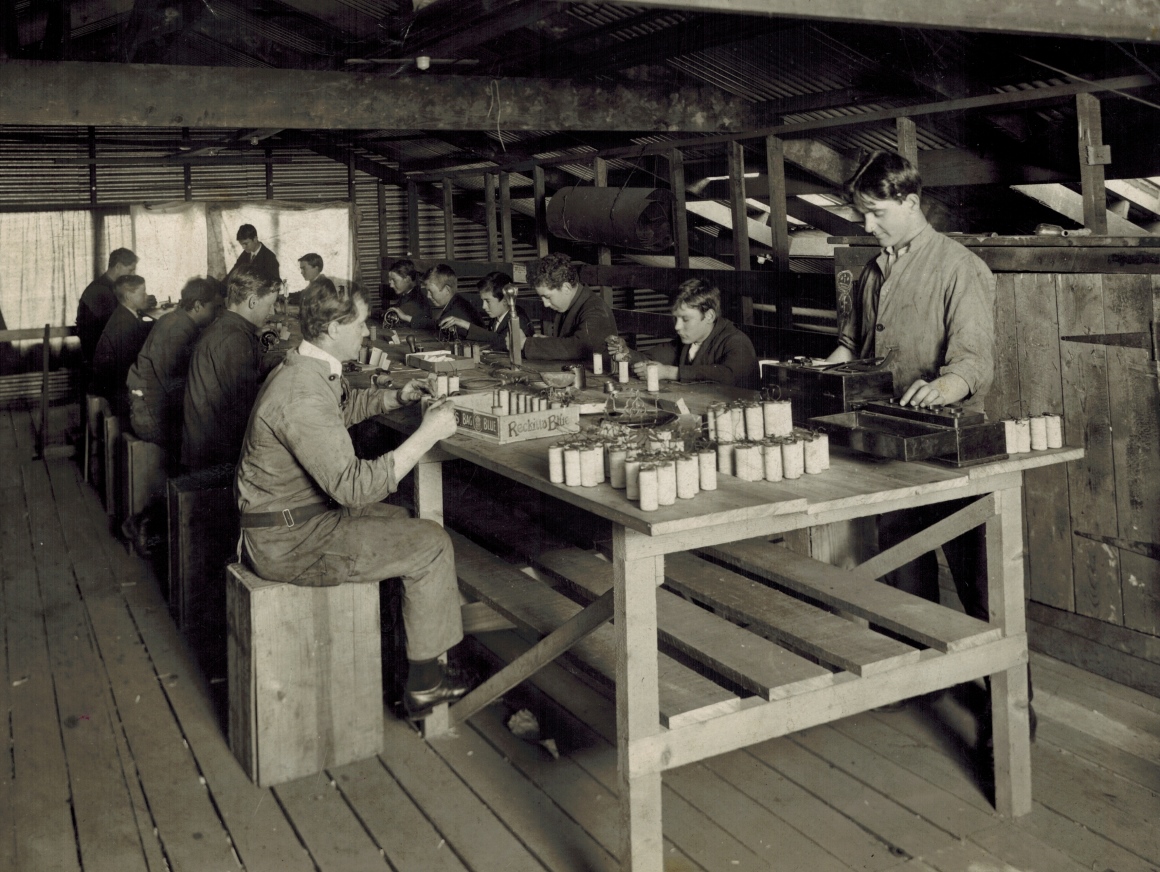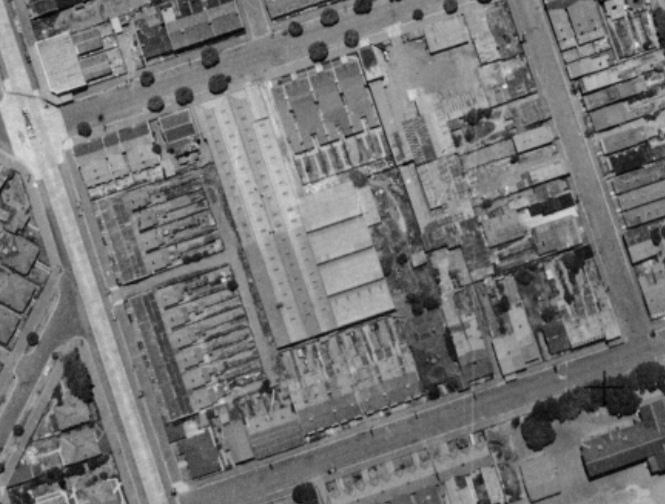This technology history page contains a photograph, which is one of several belonging to the photo gallery pages, which are part of several pages relating to the invention of the world's first automatic totalizator in 1913 and Automatic Totalisators Limited, the Australian company founded by George Julius in 1917 to develop, manufacture and export these systems.
Early Electrical Component Manufacture
This image is inside the Automatic Totalisators Limited factory at Alice Street Newtown in Sydney. My experience in the electronics industry started in 1970, a time when any component you wanted was already being mass produced. It was my guess that the manufacture being performed in this image was of capacitors, batteries or inductors. I had excluded the possibility of transformers as the devices seen here appear to have only two terminals. Neville Mitchell informed me that they are manufacturing capacitors. I have included more about this from Neville Mitchell below. Neville is an ex Automatic Totalisators Limited Manager and Engineer and the best company historian I know.
More after the image...

Click on the image to go back to the Photo Gallery
There is no photographers stamp on the photograph
The young man standing in the foreground on the right hand side of the table seems to be controlling some electrical test equipment. He is probably performing a quality control function, ensuring the manufactured devices meet the specifications. The wooden box on the table with Reckitt's Blue written on the side, in front of the first man seated on the left, refers to the box's original use containing a product of that name, which was a laundry rinse and a water additive for whitening clothes. It was popular till the 1950s. The box's new role is to contain the devices being manufactured here.
I do not think the boxes being used as seats would pass any modern OH&S posture standards, as this long predates such considerations. Only two or three of the people in this photo are of an age that you would see in a first world factory these days. Some are much younger than today's standard.
There is a stick figure with a face drawn in chalk, to the left of quality control man on the cupboard behind him right next to his right arm. It has its hands on its hips and appears to be looking up at the skylight window. A bit of brief jocularity always brightens up the situation.
The roof in the image above certainly lines up with the aerial image below confirming that this photo was taken in the Automatic Totalisators Limited factory at Alice Street Newtown.
The image below was extracted from a 1949 aerial survey photograph. I received the aerial photograph image from Naomi Crago, an archivist at the City of Sydney archives when I enquired about the Newtown Project and the Alice Street factory. It is titled City of Sydney - Aerial Photographic Survey, 1949 Map 102 and is from the Historical Atlas of Sydney.
The 1949 aerial photograph was taken after Automatic Totalisators Limited had vacated this factory and moved to Chalmers street in the city. This move took place in 1933/34. How much change to the ex Automatic Totalisators Limited factory took place in the intervening years is unknown, however it can be seen that the room in the image above could be inside one of the long thin sections of the factory shown in the aerial photograph below.
Aerial View Alice Street factory post Automatic Totalisators Limited
The image at the top of this page is perched in the A frame ceiling of the factory building, like a loft. The photograph from which the image at the top of the page originated shows more of the roof and it is clear that this is an A frame roof. The table is aligned with the apex of the roof which is also aligned with one of the long thin sections of the factory shown in the aerial photo. Two skylight windows can be seen behind the man standing, on the right hand side of the loft image at the top of this page. These skylight windows can be seen in the aerial photograph image in the two long thin sections of the factory.
As there is so much light emanating from the far end of this loft section, shining through the makeshift curtains, hung from the corrugated iron wall, presumably this loft section image is showing the end of the building. As the roof of the top of the long thin sections of the factory in the aerial image above slant backwards, until they reach the apex of the roof and there is no such evidence of slanting on the inside, visible in the image at the top of this page, it looks like the loft image belongs at the bottom of the long thin sections in the aerial image. By the way, the street that runs past the top end of the long thin sections of the factory in the aerial photo is Alice Street. If the image at the top of this page is not in the top end of this building, it is probably the bottom end. With the sky lights on the right hand side of the loft image, it cannot be in the left long thin section of the factory shown in the aerial photo, but the right, as the left long thin section does not have skylights on the right hand side when facing the outside of the factory as shown in the loft image, which is down when in the bottom section of the long thin section in the aerial photo.
Whilst I have deduced that it is likely that the end of the long thin section of the factory seen directly ahead in the loft image, is at the bottom of the right hand long thin section in the aerial photo, you might have noticed that this section has a darker roof than the section above it. I have speculated as to why the part of the factory down the bottom end of the two long thin sections shown in the aerial image, has a darker roof than the rest of this roof section above. It could be an incomplete paint job. Alternatively, could it be that the darker part is older and the lighter part an addition? As Automatic Totalisators Limited vacated this factory in 1933/34 when the factory moved to Chalmers Street in the city, there were fifteen years before the aerial survey was performed in 1949, from which the image of the aerial view of the factory comes, so it could have been altered since Automatic Totalisators Limited occupied the factory and indeed could have been extended during their own tenure in this factory. In conclusion, it could be a far cry between this factory as seen in the image at the top of this page and the aerial view in the second image. Nonetheless, the A frame roof and skylight windows are clearly visible in both images. The resolution of the aerial view image is insufficient to determine if the roof covering is corrugated material possibly iron as is clearly evident in the first image.
Following are extracts of an email from Neville Mitchell, the best ATL company historian I know:
The photo showing the manned capacitor production line is typical of the era. To the rear right you can see the young boys with winding machines, rolling the aluminium and insulating materials forming the capacitor may be 1 uf @ 100 VDC. The completed product was enclosed in a extruded vented aluminium can and sealed after filling with a Salammoniac solution.
The man with the test set up was possibly testing for insulation leakage using a high voltage 500 VDC Megga.
This type of capacitor had a limited life cycle, when used in valve radios as filters, for the rectified high voltage, they tended to dry out. The radio would develop a 100 cps hum. They were a problem, as you turned the radio upside down to do a repair, the electrolyte would leak out. Thankfully in my time we had fully sealed dry electrolytic capacitors, which we would connect directly across the old capacitors.
Julius used oil filled capacitors, later found to contain PCBs, a nasty substance. They were manufactured by the DUCON CAPACITOR company in Christina Street Chester Hill.
The Mezzanine work area where the photo was taken would have been very cold and hot according to the season. The men's seating was also notable, just packing cases! Work Cover would have a fit at these conditions.
After Neville read my comment regarding the young faces in this image he sent a further interesting email about the apprentices at Automatic Totalisators. An extract follows.
Regarding your remark about the boys working on the crude production line. ATL had a excellent policy regarding young apprentices, on average during the 1960s to 1980s there was up to 27 apprentices working in Meadowbank.
It was actually cheap labour, although they went to technical college one day a week, they were required to work at the race tracks on Wednesdays & Saturdays, trots & greyhounds in the evenings.
There was a dedicated Apprentice Master, a Ron Piddle* who looked after all their work and training needs. These boys did very well out of ATL they all drove good cars and dressed well.
Each year the boys participated in the construction of an Impulse jet engine.{a la NAZI buzz bomb.} At the Christmas holiday factory close-down morning tea, the engine was mounted on a heavy cast iron bench and would be fired up, to the delight of all the assembled staff. The noise was amazing coming from such a small engine.
At the end of the 5 year apprenticeship they were encouraged to leave ATL to gain other experience, many did return later as tradesmen. There was a definite ratio of apprentices to tradesmen requirement. Others went on to be very successful business people.
* The spelling is correct, Ron was a top guy, I went to his funeral many years ago, a celebrant dressed in a grey dust coat as Ron always wore, leant on his coffin and spoke to Ron as if in conversation about his life.

